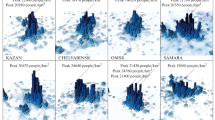Abstract
Central urban areas have become more complex and comprehensive over the last several decades. Today, the study of these areas must include an understanding of urban spatial structure and morphology. However, the predominant research perspective comes from the current interdisciplinary quantitative discussion of the spatial form of urban space structures, rather than from the use of formats to quantitatively examine urban centers or business districts. The business mode is an important aspect of research in central areas and is more reflective of the core characteristics of the urban center. This study provides an in-depth examination of the industrial morphology of urban centers, especially that of megacities. To do so, the study utilizes both quantitative and qualitative methods of case choice and kernel density analysis to link urban industrial form data with urban spatial structure. The purpose of this research is to determine the association between urban industrial form data and the relationship between urban spatial structure and urban morphology, as well as summarize the related characteristics from data and spatial statistics results. In exploring this relationship, this study addresses significant research gaps while contributing to spatial planning and related policy-making in the central urban district.





Similar content being viewed by others
References
Banzhaf, E., S. Kabisch, K. Knapp, D. Rink, M. Wolff, and A. Kindler. 2017. Integrated research on land-use changes in the face of urban transformations: An analytic framework for further studies. Land Use Policy 60: 403–407.
Brown, J.R. 2010. Managing the retail format portfolio: An application of modern portfolio theory. Journal of Retailing and Consumer Services 17 (1): 1928.
Davisa, L., and N. Hodges. 2012. Consumer shopping value: An investigation of shopping trip value, in-store shopping value and retail format. Journal of Retailing and Consumer Services 19 (2): 229–239.
Dhar, T.K., and L. Khirfan. 2017. A multi-scale and multi-dimensional framework for enhancing the resilience of urban form to climate change. Urban Climate 19: 72–91.
Fowler, K., and E. Bridges. 2010. Consumer innovativeness: Impact on expectations, perceptions, and choice among retail formats. Journal of Retailing and Consumer Services 17 (6): 492–500.
Han, M., O. Mihaescu, Y. Li, and N. Rudholm. 2017. Comparison and one-stop shopping after big-box retail entry: A spatial difference-in-difference analysis. Journal of Retailing and Consumer Services 40: 175–187.
Ogle, J., D. Delparte, and H. Sanger. 2017. Quantifying the sustainability of urban growth and form through time: An algorithmic analysis of a city’s development. Applied Geography 88: 1–14.
Pili, S., E. Grigoriadis, M. Carlucci, M. Clemente, and L. Salvati. 2017. Towards sustainable growth? A multi-criteria assessment of (changing) urban forms. Ecological Indicators 76: 71–80.
Shi, B., and J. Yang. 2015. Scale, distribution, and pattern of mixed land use in central districts: A case study of Nanjing, China. Habit International 46: 166–177.
Teller, C., H. Kotzab, B. David, and D.B. Grant. 2012. The relevance of shopper logistics for consumers of store-based retail formats. Journal of Retailing and Consumer Services 19 (1): 59–66.
Valls, F., E. Redondo, D. Fonseca, R. Torres-Kompen, S. Villagrassa, and N. Marti. 2018. Urban data and urban design: A data mining approach to architecture education. Telematics and Informatics 35 (4): 1039–1052.
Wang, D., Y. Nong, and W. Zhu. 2011. Study on consumer behavior and commercial space structure of Wangfujing Street. City Planning Review 35 (7): 43–60.
Acknowledgements
This study is supported by the National Natural Science Foundation of China (Grant Nos. 51708296 and 51708103) and China Postdoctoral Science Foundation (Grant No. 2017M611823).
Author information
Authors and Affiliations
Corresponding author
Rights and permissions
About this article
Cite this article
Shi, Y., Hu, X., Yang, H. et al. Format compositions and spatial distribution characteristics of central districts in megacities: People’s Square and Shanghai’s Lujiazui District. Urban Des Int 24, 260–270 (2019). https://doi.org/10.1057/s41289-018-0077-9
Published:
Issue Date:
DOI: https://doi.org/10.1057/s41289-018-0077-9




